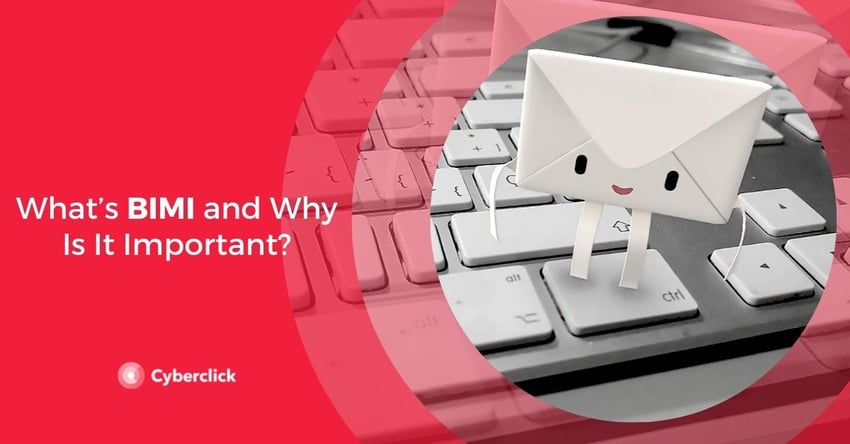BIMI is a term that most marketing leaders have probably encountered at one point or another. It stands for Brand Indicators for Message Identification, an emerging standard that makes it easier to get your logo displayed next to your message in a customer’s inbox. Aside from looking nice, it also helps to reassure buyers that you are who you say you are, creating trust and improving the customer experience. And with phishing, spoofing, and fraudulent emails on the rise, this extra layer of protection is more important than ever.
As BIMI is still a relatively new standard, you may not know much about it yet. That's why we have put together this guide to help you understand what BIMI is and how it can benefit your brand. We will also explain how it works so that you can implement it as part of your marketing strategy and take your consumer confidence to the next level.

What Is BIMI?
BIMI stands for Brand Indicators for Message Identification. It is an email specification that allows you to attach your brand's logo to your authenticated email messages. It is a simple, visual verification that allows recipients to recognize and trust the messages you send. Current participating mailbox providers include Yahoo and Gmail.
The standard was developed by The AuthIndicators Working Group, a vendor-neutral committee of companies working to create a richer, more trustworthy inbox experience for all email users worldwide through increasing the use of authentication to reduce email fraud. Put simply, it is a text record rooted on your servers that works alongside additional email authentication methods including SPF, DMARC, and DKIM to signal to email recipients that you are who you say you are.
Although a number of email clients already add logos to inbox messages, with BIMI you control which logo or image is displayed. This helps you retain control over your brand and subscriber experience, helping you to further develop consumer trust.
How Can BIMI Help Your Brand?
The obvious benefit to using BIMI is that it provides you and your customers with improved security. This promotes trust in your brand and helps to improve the user experience.
Let’s take a look at the biggest benefits in a bit more detail.
Security Updates
BIMI adds another layer of security to emails as it requires strong authentication and verification of logos before they're displayed. It also leverages behind-the-scenes security updates, safeguarding you from impersonators and protecting your brand's reputation.
Reduced Phishing Attempts
The security benefits don’t stop there - you also get an extra layer of protection against phishers and spoofers by deploying and enforcing email authentication. This also promotes security hygiene and encourages the email ecosystem to take better precautions. Plus, it’s a great way to educate your customers so that they know how to identify emails that are not legitimate.
It Helps You Stand Out
Aside from security, you also get a few benefits from a visual point of view. Having your brand’s logo appear in a customer’s inbox looks nice and helps you stand out from the crowd. This reinforces brand awareness and helps potential buyers view you as a credible, professional organization, further establishing your brand and reputation.
How Does BIMI Work?
So, now that we’ve seen what BIMI is and how it can benefit your brand, let’s take a look at how it works.
Identify Your Sending Domain
First and foremost, BIMI is a text record that is hosted on your sending servers. This means that your email authentication protocols and your BIMI record needs to be published on the DNS server your organization uses to send emails.
A domain host is an internet service that manages your domain name, such as, example.com. Domain hosts use Domain Name System (DNS) records to connect your domain name with email, websites, and other web services. Popular domain hosts include GoDaddy, DreamHost, and IONOS, to name a few. Contact your domain hosting provider if you are not sure.
Align Email Authentication
The next step is to implement DMARC authentication on all marketing emails.
In order to get a BIMI logo to display, you’ll need a DMARC policy that is set to either “p=quarantine” or “p=reject”. A DMARC policy of “p=none” is not BIMI compliant.
DMARC looks for SPF and DKIM alignment. If an email fails authentication, it won’t be delivered.
Create a BIMI Logo
Step 3 is creating your BIMI logo. This might be your brand logo, or another image you want to be displayed next to your name in all emails. Whatever you go for, your image file must be in the SVG P/S Tiny 1.2 format. It needs to be square, centred and contain no text. You also need to make sure the logo looks good when it’s cropped in a variety of ways as each inbox uses its own unique dimensions.
Full image requirements, including required elements in the structure of the SVG file, can be found here.
Get a Verified Mark Certificate (VMC)
For some implementations, you may also need a Verified Mark Certificate (VMC) that validates your logo as belonging to your organisation. In other words, you need to get your logo trademarked and verified by the right authorities, then you need to obtain a VMC to prove authenticity.
Currently, the two entities providing VMCs are Entrust and DigiCert.
Publish Your BIMI Record to the DNS
Now comes the most important step: publishing your BIMI record to the DNS. This is a type of DNS Resource Record (DNS RR) much like an MX, DMARC or DKIM record.
Several technical considerations should be made when constructing the actual BIMI DNS record. Initially, the record should be published in a zone named “default._bimi”, located directly under the second level domain. Its contents are a fixed version string “v=BIMI1” followed by a separator (; and optional space) and then an ‘l=‘ tag.
Verification
Finally, you need to check everything complies with established BIMI standards. This includes verifying that the record you just created has the correct values and syntax. You also want to see how your logo will appear in emails.
There are a number of online tools you can use for this, such as the BIMI Inspector tool from BIMI Group, MxToolbox, and Red Sift’s OnDMARC.
Key Account Manager Engineer en Cyberclick. Experto en desarrollo de aplicaciones web e integraciones entre sistemas con más de 10 años de experiencia. Cuenta con una licenciatura en Matemáticas, Ciclo Formativo de Grado Superior en Desarrollo de Aplicaciones Informáticas y Ciclo Formativo de Grado Superior en Desarrollo de Aplicaciones Multiplataforma.
Key Account Manager Engineer at Cyberclick. Expert in web application development and system integrations with over 10 years of experience. He holds a degree in Mathematics, a Higher Degree in Computer Application Development, and a Higher Degree in Multiplatform Application Development.






Leave your comment and join the conversation